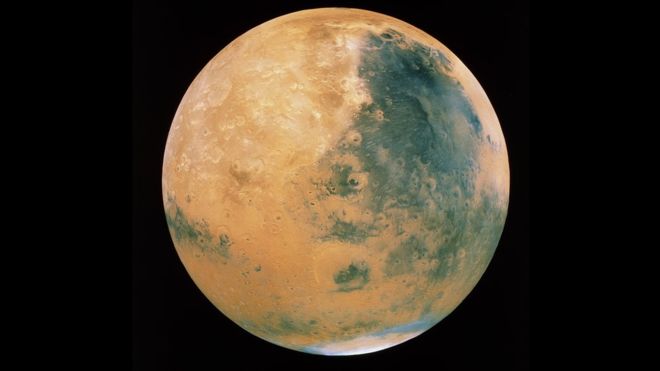Researchers have found evidence of an existing body of liquid water on Mars.
Source: BBC News
What they believe to be a lake sits under the planet’s south polar ice cap, and is about 20km (12 miles) across.
Previous research found possible signs of intermittent liquid water flowing on the martian surface, but this is the first sign of a persistent body of water on the planet in the present day.
Lake beds like those explored by Nasa’s Curiosity rover show water was present on the surface of Mars in the past.
However, the planet’s climate has since cooled due to its thin atmosphere, leaving most of its water locked up in ice.
The result is exciting because scientists have long searched for signs of present-day liquid water on Mars, but these have come up empty or yielded ambiguous findings.
It will also interest those studying the possibilities for life beyond Earth – though it does not yet raise the stakes in the search for biology.
The discovery was made using Marsis, a radar instrument on board the European Space Agency’s (Esa) Mars Express orbiter.
“It’s probably not a very large lake,” said Prof Roberto Orosei from the Italian National Institute for Astrophysics, who led the study.
Marsis wasn’t able to determine how thick the layer of water might be, but the research team estimate that it is a minimum of one metre.
“This really qualifies this as a body of water. A lake, not some kind of meltwater filling some space between rock and ice, as happens in certain glaciers on Earth,” Prof Orosei added.
How was it found?
Radar instruments like Marsis examine the surface and immediate subsurface of the planet by sending out a signal and examining what is bounced back.
The continuous white line at the top of the radar results above marks the beginning of the South Polar Layered Deposit; a filo pastry-like accumulation of water ice and dust.
Beneath this, researchers spotted something unusual 1.5km under the ice.
“In light blue you can see where the reflections from the bottom are stronger than surface reflection. This is something that is to us the tell tale sign of the presence of water,” says Prof Orosei.
What does this mean for life?
Nothing definitive. Yet.
Dr Manish Patel from the Open University explained: “We have long since known that the surface of Mars is inhospitable to life as we know it, so the search for life on Mars is now in the subsurface.
“This is where we get sufficient protection from harmful radiation, and the pressure and temperature rise to more favourable levels. Most importantly, this allows liquid water, essential for life.”
This principle of following the water is key to astrobiology – the study of potential life beyond Earth.
So while the findings suggest water is present, they don’t confirm anything further.
“We are not closer to actually detecting life,” Dr Patel told BBC News, “but what this finding does is give us the location of where to look on Mars. It is like a treasure map – except in this case, there will be lots of ‘X’s marking the spots.”
The water’s temperature and chemistry could also pose a problem for any potential martian organisms.
In order to remain liquid in such cold conditions (the research team estimate between -10 and -30 Celsius where it meets the ice above), the water likely has a great many salts dissolved in it.
“It’s plausible that the water may be an extremely cold, concentrated brine, which would be pretty challenging for life,” explained Dr Claire Cousins, an astrobiologist from the University of St Andrews, UK.
What next?
While its existence provides a tantalising prospect for those interested in the possibility of past or present life on Mars, the lake’s characteristics must first be verified by further research.
“What needs to be done now,” explained Dr Matt Balme from the Open University, “is for the measurements to be repeated elsewhere to look for similar signals, and, if possible, for all other explanation to be examined and – hopefully – ruled out.
“Maybe this could even be the trigger for an ambitious new Mars mission to drill into this buried water-pocket – like has been done for sub-glacial lakes in Antarctica on Earth,” he added.
Scientists have previously claimed to find bacterial life in the buried depths of Antarctica’s Lake Vostok, but drilling on Mars would make for an ambitious project indeed.
“Getting there and acquiring the final evidence that this is indeed a lake will not be an easy task,” said Prof Orosei.
“It will require flying a robot there which is capable of drilling through 1.5km of ice. This will certainly require some technological developments that at the moment are not available.”
The findings were reported in Science.
Source: BBC News

































Leave a Comment
You must be logged in to post a comment.